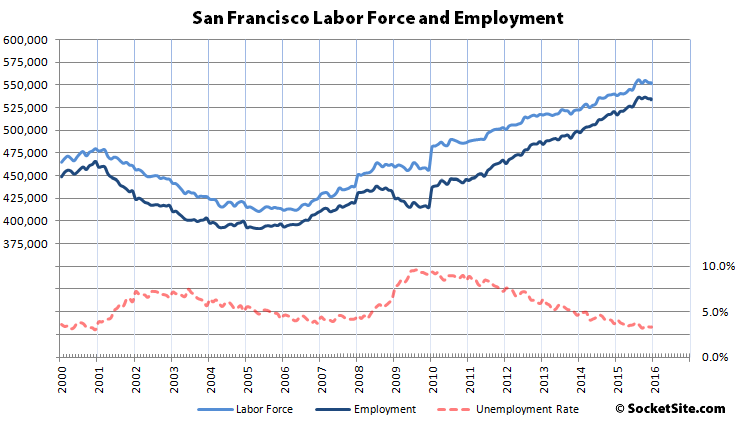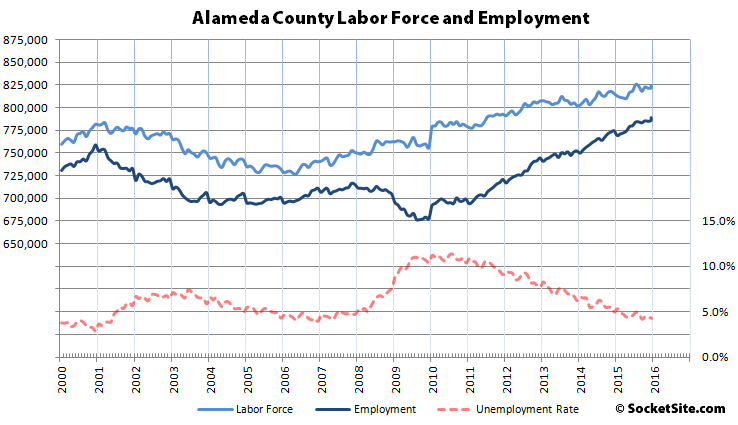For the third month in a row, the number of people living in San Francisco with a job has slipped, dropping by 1,200 in January to 533,400.
But a dip in the first month of the year is to be expected as seasonal employees are shed. And with the labor force in San Francisco having dropped by 1,000 as well, the unemployment rate remained at 3.3 percent, the second lowest unemployment rate in San Francisco since December 2000.
There are now 67,900 more people living in San Francisco with paychecks than there were at the height of the dot-com peak in 2000, which is 16,700 higher over the past year and an increase of 96,700 since January of 2010, but 3,000 fewer than three months ago.
At the same time, employment in Alameda County, which includes Oakland, jumped by 3,200 in January to 789,400, an increase of 19,300 over the past year and 3,500 higher versus three months ago.


Always the best of times / worst of times. Low unemployment, very low interest rates, low inflation, high growth geography, gradually loosening credit standards. Lots of talk about the softening local SF market. Perhaps we’re simply leveling-off while the outer counties take another leg up in price.
I’m fascinated by this concept of “leveling-off.” Can you cite examples of these level markets?
Condo prices are “leveling-off“.
In the English language, “level” means unchanging. The headline you link to says, “Price Index for New Condos in SF Drops”. The headline doesn’t say, “Price Index for New Condos in SF is Unchanged”.
Are you using “drops” and “unchanged” as synonyms? Or maybe referring to a drop as a “leveling off” is ad copy?
@Two beers – come on now. I know you are better than this. Look at the detail and use your noggin. Level means unchanged. Its all about how you measure it. Year over year, prices are moving to a level where they will be unchanged from a year ago.
Is this a real trend? Job growth stalling in SF relative to other Bay Area locales and other cities (Reno expecting 50K new jobs in next 6/7 years)?
The cost of doing business in SF is too high for many/most companies. One thing that had hidden that in a sense is the VC funding and start-ups these past years. Flush with money these companies would pay exorbitant SF office rents that more traditional companies can’t.
Maybe that phenomena is coming to an end?
.
But more traditional companies can’t.U
If an Oakland resident gets a job in SF while an SF residents loses his oakland job does that mean SF’s job market is cooling down? While a lot of people of people do work in the same city they live not everyone does. 2/3 of our SF household work outside the city.
The margin-of-error on these stats is too large to be affected by whatever happens in a few households.
The Census defines MSA to better represent a job market than the county boundaries. SF MSA includes SF and 4 adjacent counties. FWIW, about 10% of those Alameda county employed residents work in SF and ~45% of all the jobs located in SF are done by people that live outside SF but in the SF MSA. Similarly, about 20% of the SF county employed residents place of work is outside SF, but almost all SF employed residents work in the SF MSA.
I agree, I just used a real life example to illustrate what you are saying, that the county level employment of residents doesn’t match up exactly with where the jobs are. As you point out, roughly 45% of SF jobs are filled by people that don’t live in SF. Those numbers don’t measure where the jobs are, they just measure the employment rates in the various counties for residents. They do not prove that if a few less SF residents are employed it is because the SF economy slowed down while Alameda’s picked up.
The last few months on the S.F. graphs starting to look uncomfortably like 2001 and 2007-2008… let’s hope that it’s just a pause before a 2nd round of growth, and not a sign of things to come.
Yes, “let’s hope” some deus ex machina saves the collapsing profitless unicorn app bubble, because there are still some blue collar workers and minority families that have yet to be driven from SF.
Well there’s always a Donald Trump presidency to look forward to…
Your glee is misplaced. You should check who suffers in recessions.
You should check who causes recessions. What’s your point, that those who can barely get by in “good” times because the system is rigged against them should hope that the wealth-sucking oligarch parasite zombie vampires who have no real value to society don’t face hits to their high value assets after their orgy of poorly-allocated and unproductive speculation, because that can cause an interruption in the parasite zombie vampires trickling down on productive workers? Yes, recessions are hardest on those at the bottom, and god forbid the useless gluttons who now receive all of the gains to productivity have to endure a decline in the rate of increasing amassing of wealth.
You used zombie twice. When ranting incoherently, it’s best to not repeat words.
I’m sorry if my description of people you admire makes you uncomfortable.
By deus ex machina, do you mean Apple, Google, Facebook, and Oracle?
Yes we need a second round of growth badly, because today only 11% of SF households can afford the median priced home, let’s see if we can get that to 5% shall we?
WSJ Reports that funds are marking down their private investments in many tech startups.
“Mutual funds that helped fuel the technology boom are cutting the value of their startup investments at an accelerating pace and are making fewer new investments.
These are ominous signs for Silicon Valley, where a flood of money into young companies pushed valuations skyward, and subsidized hiring sprees and advertising binges at scores of companies.
The mutual-fund pullback threatens to deepen a wider downturn that has already led to falling valuations, shrinking ambitions and layoffs as the receding tide of capital forces startup companies of all kinds to focus on the bottom line rather than growth at any cost.”
It’s much more opaque this time around because most of these companies are being traded and valued privately vs on the pubic markets.
Focusing on costs for the dwindling supply of VC money start-ups are seeking will mean IMO a pullback on leasing up space at any cost. As Linked-In took that Howard (is it) Street building.
SF’s overpriced office market could really feel a pinch as companies pull out and/or start-ups search for cheaper digs.
Someone commented a few days back here that there has been a jump in SF sub-leased office space. They did not post a source and I don’t know if its true but that would be a potential leading indicator if it is true or if we start to see that.
Let’s hope wearables, vr, and drones can save the sf tech industry.
What happened in 2010? That seems like an unlikely jump in the chart data.
It’s very simple, the affordability ceiling has been hit. Both the companies and their employees simply cannot keep burning through cash like this.
Anecdotal but the owner of a home a few doors away from me rents out a large 1bedroom/1batch sub-basement room to two techies pushing 30. They pay 4000/month. Both are looking for jobs in the East Bay and out of the area.
Only in SF can one have a good paying job, hi-tech college degree and all and still live as one did in college. With roommates.
SOMA is a draw for millennias but cities like Portland and Seattle have similar “hot” spots that draw this group. SOMA has nothing on Portland’s Pearl District which evolved organically, retained most of the beautiful old buildings, built new condos and townhomes which did not overpower the district. A true intimate neighborhood. What many young tech workers want and in the case of Portland where they can also afford to buy a condo or home. or if they want to rent they can so do without having to have a roommate to help pay a ridiculously high rent.
So yeah, its a case of companies and employees simply not being able to afford the price level SF has reached.
Honest question: How many billionaires under 40 has Portland produced?
Or billionaires over 40…..
That is not the point. It is not the fulcrum of tech development that the SV is and what city is?
The point is it offers a place to live, bring up families, have a good paying tech job and own a home. It offers a real alternative to young and not so young to not have a future where there are suddenly 50 and still renting an over-priced apartment in SF with little to show for it.
Price levels companies and employees can tolerate have a ceiling. In the sense of “worker bee” employees. The billionaires will be fine and the multi, multi millionaires too. But that excludes most tech workers.
We saw it with AT&T, Chevron, BofA, Schwab. Not tech companies but the parallel example of their day where their large middle level workforce was moved out of SF and of the state in some cases.
Its not a good sign when UCSF and Google have to build housing to keep or attract top level employees. Its a good thing for them to do for sure, but a sign something is way off when some potential professors are reluctant to relocate to UCSF from other areas because of the costs here. In UCSF, to clarify, the planned housing is for students and staff.
I will definitely agree with you that our housing is ridiculously expensive. It’s absurd that Google is even thinking about building housing. It marks a collective failure of governments large and small (SF, but only SF, also Palo Alto, Mountain View, etc.) to bock new housing.
It’s really a state failure caused by the poor incentive structure in place due to prop 13. LA/SD are almost as bad on how expensive housing is relative to their much lower incomes.
Seattle and Washington generally has done much better on this count, though I don’t really get the praise for Oregon – that state has done ok I guess, but Portland has far lower incomes and much higher unemployment rate than SV or the Puget Sound area, and it’s not really a town with a lot of tech jobs.
“It marks a collective failure of governments large and small […] ”
Yes, because when a non-fungible, localized, inherently imperfectly-competitive asset market like housing disequilibriates due to multiple unsustainable exogenous speculative inputs, it has to be because there was too much gummint regumalation, and not because there was too little.
Are you seriously defending prop 13?
How in the world did the Pearl District develop “organically”? It’s pointed to as one of the best examples of urban planning in the US, and was COMPLETELY master planned by the city.
Organic in the sense that it is yes planned but done so in a way keeping many of the old buildings and organically developing the area in that context. There are new projects (Riverscape is one I was involved with) of course but they are not overpowering.
Its a true “planned” neighborhood with phenomenal street level experience in a way MB has not become.l
I think MB could have used more of a mix of parcel sizes. PDX has a smaller avg lot size in its main redev areas vs SF, giving your “organic” feel. Still SW waterfront feels distinctly like MB to me. Need to wait for Central Subway to really see what MB becomes.